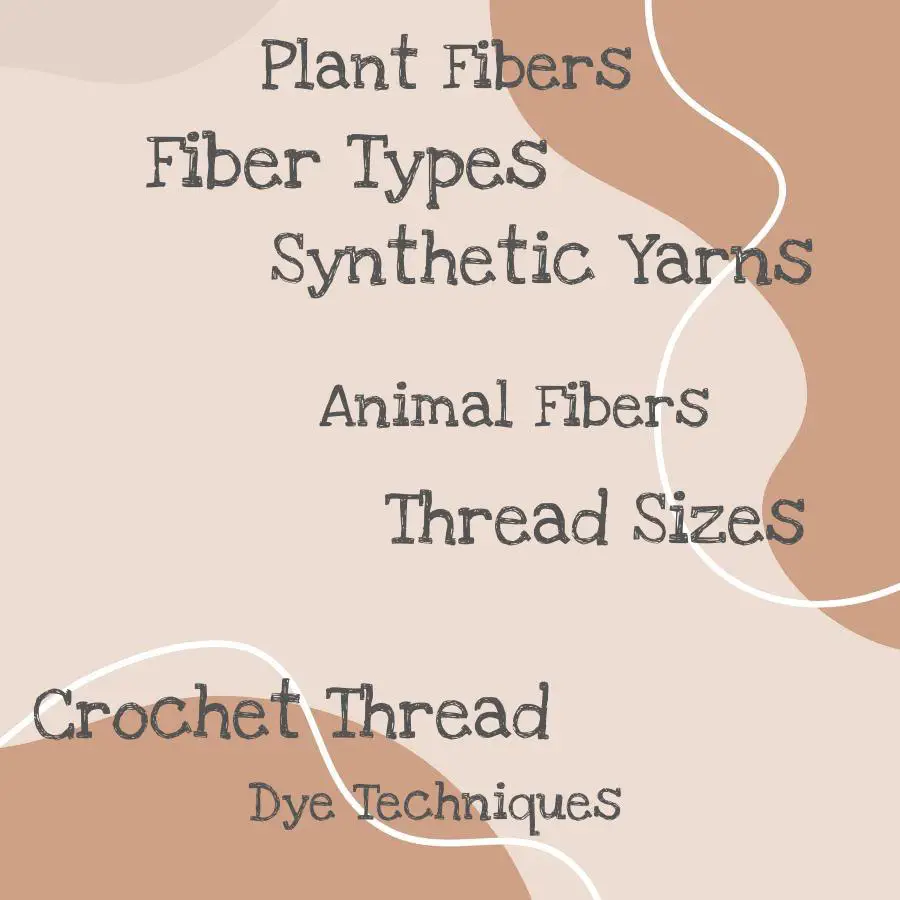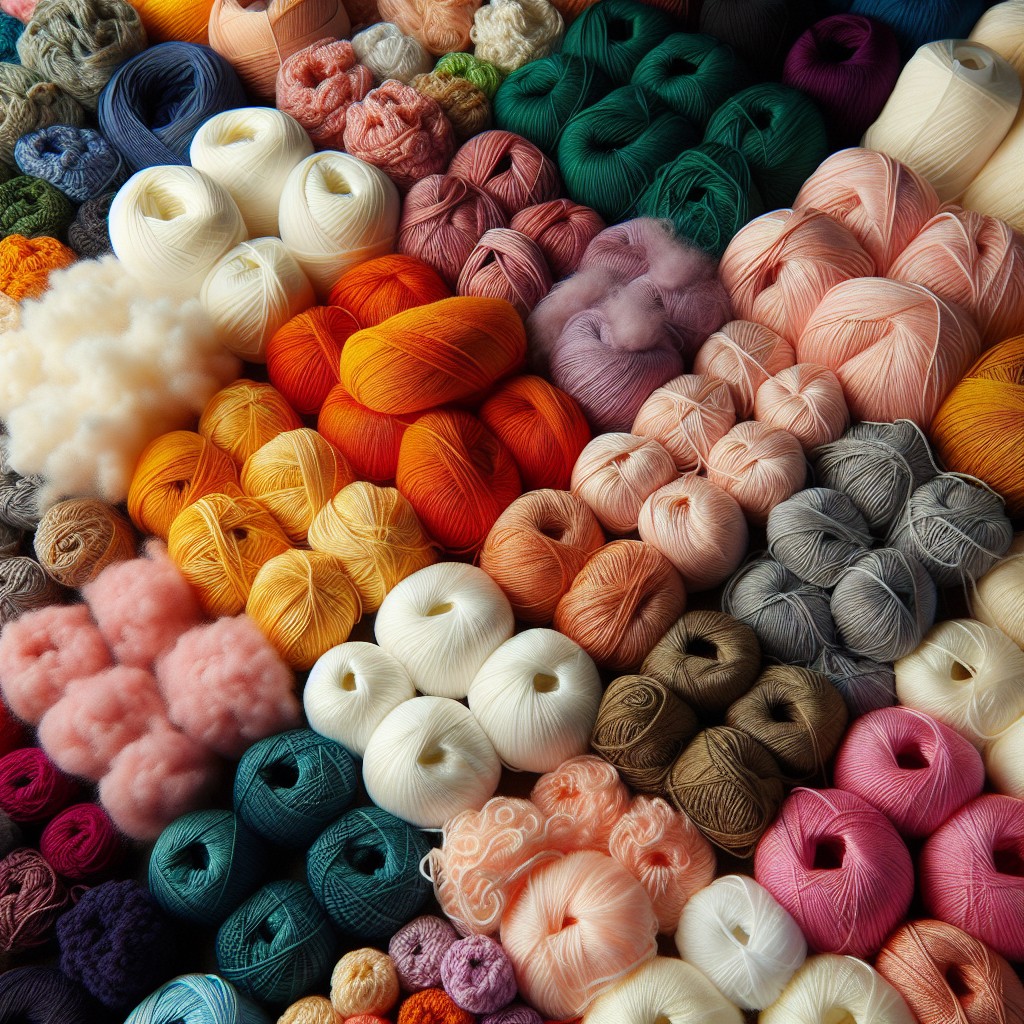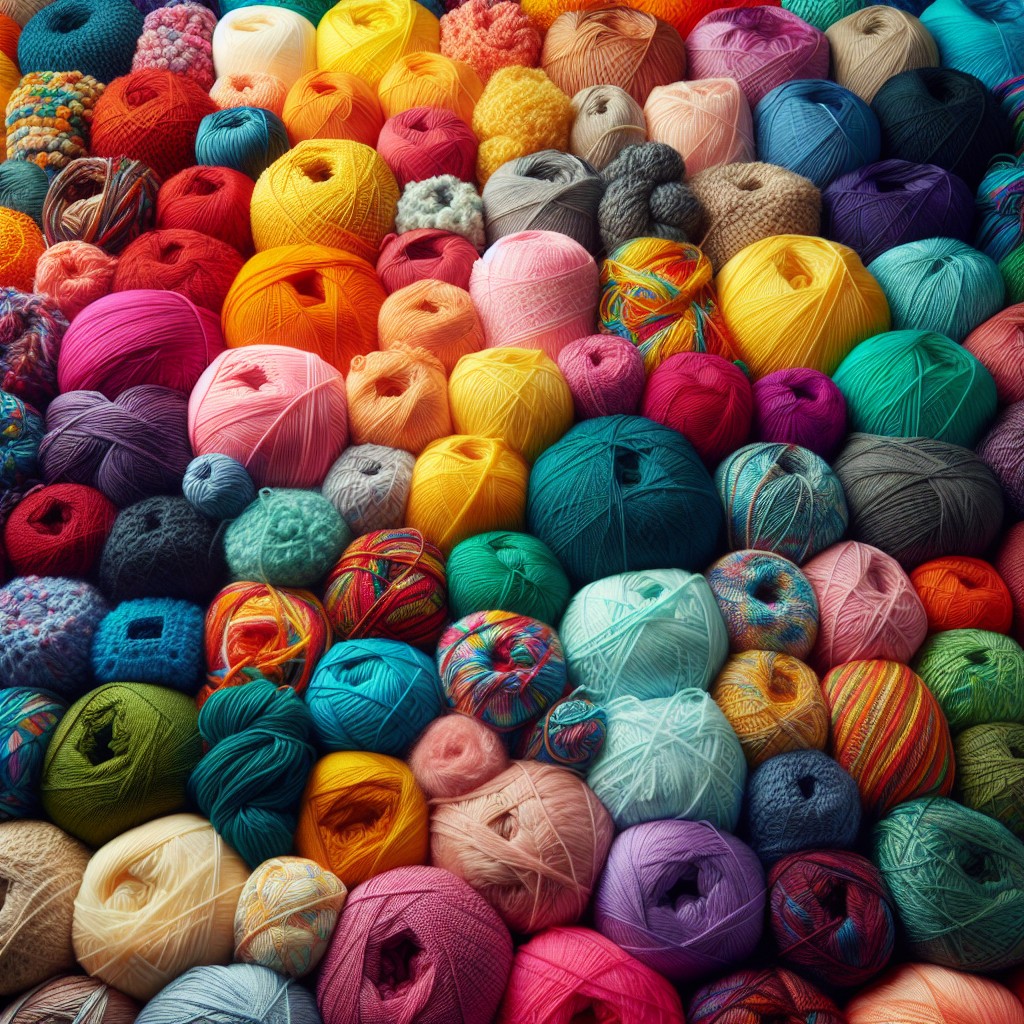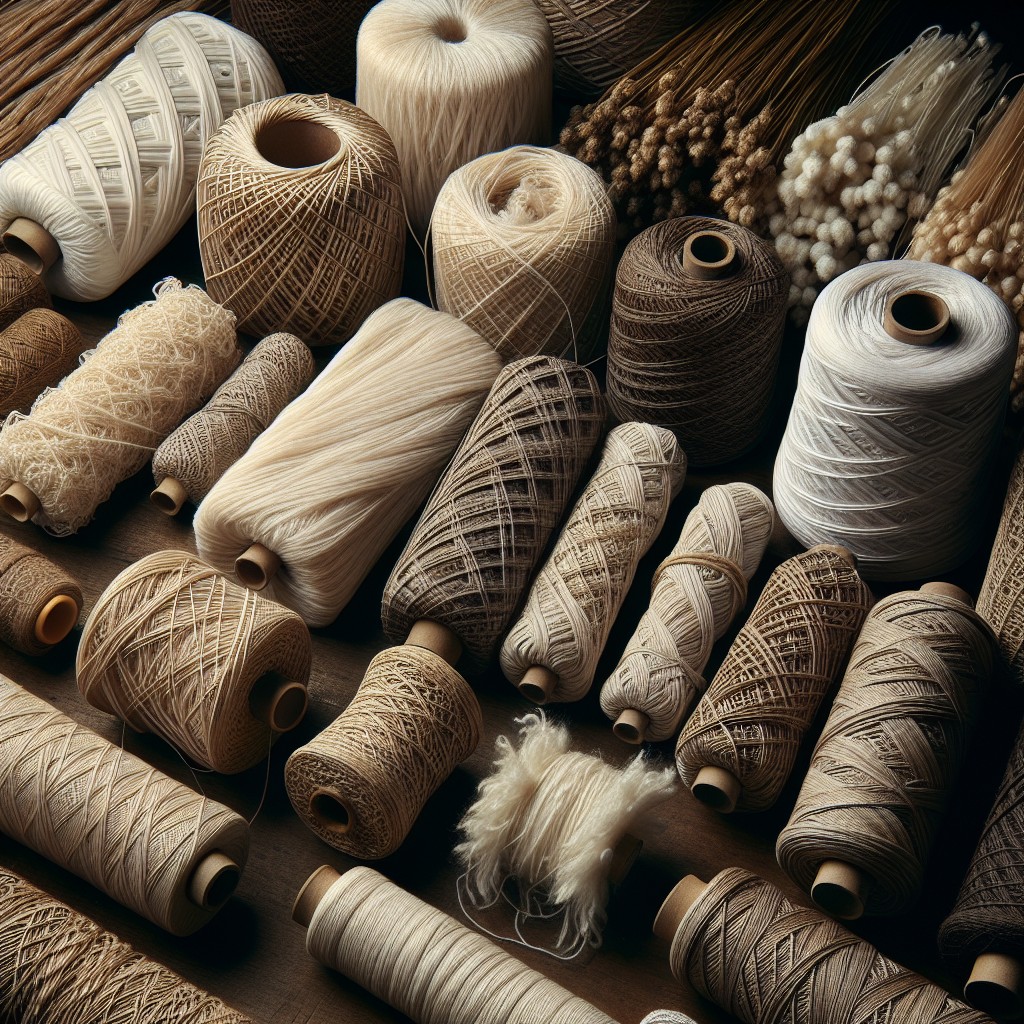Discover the diverse world of crochet thread types as we unravel their unique characteristics, perfect for an array of intricate projects you’ll love to create!
Crocheting is a beloved hobby that brings joy to millions of people worldwide. It’s a craft that allows you to create beautiful and intricate designs using just a hook and some thread.
But with so many different types of crochet thread available, it can be overwhelming trying to choose the right one for your project. In this blog, we’ll explore the various types of crochet thread, their unique characteristics, and what projects they’re best suited for.
From cotton to silk and everything in between, let’s dive into the world of crochet thread!
Understanding Thread Sizes

Thread size refers to the thickness of the thread and can vary greatly depending on its intended use. The most common sizing system for crochet thread is based on numbers, with lower numbers indicating thicker threads and higher numbers representing thinner ones.
The numbering system can be a bit confusing at first glance, but once you understand it, choosing the right size becomes much easier. For example, a #10 cotton crochet thread is thicker than a #30 cotton crochet thread.
It’s important to note that not all brands follow this numbering system exactly; some may have their own unique sizing methods or use letters instead of numbers. Always check your pattern for recommended yarn weight and hook size before starting any project.
Fiber Types

There are many different types of fibers available, each with its unique characteristics and properties.
Animal fibers such as wool and alpaca are popular choices for crochet thread due to their warmth and durability. They’re also great for creating textured designs that stand out.
Plant-based fibers like cotton or bamboo offer a soft feel that’s perfect for delicate projects like doilies or baby blankets. These materials tend to be more breathable than animal-based options, making them ideal for warmer climates.
Synthetic yarns made from acrylic or nylon have become increasingly popular in recent years due to their affordability and versatility. They come in an array of colors, textures, and thicknesses suitable for various projects ranging from amigurumi toys to home decor items.
Blends combine two or more types of fiber into one strand resulting in unique texture combinations while maintaining some benefits from both materials used.
Synthetic Yarns

These types of crochet threads are made from man-made fibers such as acrylic, nylon, or polyester. They come in a wide range of colors and textures that mimic natural fibers like wool or cotton.
One advantage of using synthetic yarn is its resistance to shrinking and stretching. It’s also easy to care for since it can be machine washed without losing its shape or color.
Another benefit is that it’s hypoallergenic which makes it perfect for people with sensitive skin who may have allergic reactions to animal-based fibers.
Some popular brands include Red Heart Super Saver, Caron Simply Soft, Lion Brand Vanna’s Choice among others. Synthetic yarns work well with projects like blankets because they hold up well over time due to their durability.
Animal Fibers

These fibers come from animals such as sheep, alpaca, cashmere goats, and even rabbits. They are known for their warmth and durability while being incredibly soft to the touch.
Wool is one of the most popular animal fibers used in crocheting due to its versatility. It comes in various weights ranging from lace weight to bulky weight making it perfect for different projects like scarves or blankets.
Alpaca fiber is another favorite among crocheters because of its silky texture that drapes beautifully when worked up into shawls or wraps. Cashmere goat fiber is also highly sought after due to its incredible softness but can be quite expensive compared with other types of yarns.
Plant Fibers

These fibers come from plants such as cotton, bamboo, linen, and hemp. Cotton is the most commonly used plant fiber in crochet thread due to its softness and versatility.
It’s perfect for creating lightweight garments like summer tops or baby blankets.
Bamboo is another plant fiber that has gained popularity in recent years due to its sustainability factor. It’s also incredibly soft with a silky texture that makes it ideal for creating luxurious shawls or scarves.
Linen has been used in textiles since ancient times because of its durability and strength. Linen crochet thread creates beautiful textured pieces with excellent stitch definition making it perfect for home decor items like table runners or placemats.
Hemp is an eco-friendly option that produces strong durable threads suitable for bags, baskets, rugs among other things. When choosing plant-based yarns consider the drape you want your finished project to have as well as how breathable you need it to be depending on what type of garment you’re making.
Blends
Blended threads can be made from animal and plant fibers or synthetic materials, creating unique textures and colors that add depth to your projects. For example, cotton blended with silk creates a soft yet durable thread that’s perfect for delicate lacework or shawls.
Wool blends offer warmth and elasticity while still being lightweight enough to create cozy blankets or scarves.
When choosing a blend, consider the fiber content carefully as it will affect how your project turns out. A higher percentage of one type of fiber may make the yarn more prone to pilling or stretching than another blend with less of that same material.
Dye Techniques
That’s why it’s essential to choose a dye technique that complements the design you have in mind. There are several dye techniques used for crochet threads, each with its unique effect on the yarn.
Self-striping is a popular technique where different colors are dyed onto one skein, creating stripes as you work through it. Ombre is another method where one color gradually fades into another along the length of the thread.
Speckles and semi-solid dyes create an eye-catching effect by adding small dots or patches of contrasting colors throughout a solid-colored skein.
Color pooling involves strategically placing stitches to create patterns using variegated yarns with short color repeats. This creates an interesting visual texture that adds depth and dimension to any project.
Self-Striping
Self-striping thread comes in a variety of colors and creates stripes as you work through your project. The length of each stripe can vary depending on the brand and type of thread used, but it’s an easy way to create beautiful designs with minimal effort.
Some popular brands that offer self-striping threads include Red Heart Super Saver Stripes, Lion Brand Mandala Yarn, and Caron Cakes Yarn. When working with self-striping threads, it’s important to keep in mind that the pattern may not always match up perfectly when joining rounds or rows due to variations in dye lots or tension changes while crocheting.
However, this can also add unique character and charm to your finished piece! Self-stripping threads are perfect for creating scarves, shawls or blankets where long stripes will be visible across multiple rows. Overall if you want an effortless way to incorporate different colors into your projects then give self striping yarns a try!
Ombre
This technique can be applied to crochet thread, creating beautiful and unique projects with subtle color changes. Ombre crochet thread is perfect for shawls or scarves where the gradual change in colors adds depth and dimension to your work.
When working with ombre crochet thread, it’s important to consider how the colors will blend together as you stitch. Depending on the pattern you’re using, you may want to choose a specific starting point in your skein of yarn so that certain colors are more prominent than others.
Some popular brands of ombre crochet thread include Red Heart Super Saver Ombres and Lion Brand Mandala Ombré. These threads come in various weights and fiber types such as acrylic or cotton blends.
Speckles
This technique involves adding small, random specks of color throughout the thread, creating a beautiful and unpredictable effect. Speckled yarns are perfect for adding pops of color to otherwise plain designs or for creating eye-catching patterns.
When working with speckled yarns, it’s important to consider how the colors will interact with each other in your project. Some speckled yarns may have more dominant colors than others, so it’s essential to swatch before starting your project.
One popular way of using speckles is by pairing them with solid-colored threads in complementary hues. This creates an interesting contrast between the two types of threads while still allowing the colorful flecks in the speckled thread to shine through.
Semi-Solid
It’s not quite solid, but it’s also not variegated or self-striping. Instead, semi-solid yarns have a single base color with slight tonal differences throughout the skein.
These tonal changes can be very subtle or more pronounced depending on the dye technique used.
One of the benefits of using semi-solid crochet thread is that it adds depth and interest to your projects without being too distracting from any stitch patterns you’re working on. This makes them perfect for intricate lacework or textured stitches where you want to showcase your stitching skills without overwhelming them with bold colors.
When choosing a semi-solid crochet thread, consider what other colors will be present in your project and choose one that complements those hues well while still adding some visual interest through its own unique tones.
Color Pooling
This method can be used with any type of crochet thread, but it’s particularly effective with self-striping yarns. By carefully manipulating the colors in the yarn, you can create stunning designs that are sure to impress.
To achieve color pooling, you’ll need to pay close attention to your tension and stitch count as you work through your project. The goal is to make sure that each color in the variegated yarn lines up perfectly with its corresponding stitch from the previous row.
While this technique may take some practice and patience, it’s well worth it for the beautiful results you’ll achieve. Color pooling works especially well for scarves and blankets where long rows of stitches allow for more intricate patterns.
Spin Styles
There are two primary spin styles: S-twist and Z-twist. The direction of the twist determines whether it’s an S or Z twist, with most crochet threads being either one or the other.
S-twisted yarns are spun in a counterclockwise direction, while Z-twisted yarns are spun clockwise. This difference may seem small, but it can affect how your stitches look and how well they hold up over time.
Loosely-spun threads tend to be softer and more pliable than tightly-spun ones but may not hold their shape as well when used for intricate designs like lacework. Tightly-spun threads offer excellent stitch definition but may feel stiffer to work with.
When selecting your crochet thread, consider what type of project you’re working on and what kind of stitch definition you want to achieve before choosing between an S or Z twist style.
Mercerized
Mercerization is a process that involves treating cotton yarn with sodium hydroxide, which causes the fibers to swell and become stronger and more lustrous. The result is a smooth, shiny thread that’s perfect for creating intricate designs.
One of the benefits of mercerized crochet thread is its durability. The treatment process makes it less likely to shrink or fade over time, making it ideal for projects that will be washed frequently or exposed to sunlight.
Another advantage of mercerized crochet thread is its versatility in terms of color options. Because the fibers are so absorbent after being treated with sodium hydroxide, they can hold dye exceptionally well resulting in vibrant colors.
Loosely Spun
This results in a softer and more pliable texture, making it perfect for creating delicate lacework or garments with drape. Loosely spun threads are also great for adding texture to your projects.
When working with loosely spun crochet thread, it’s important to keep in mind that the fibers may be more prone to splitting or snagging due to their looser twist. However, this can easily be avoided by using a smaller hook size and being mindful of your tension while crocheting.
Some popular brands of loosely-spun crochet thread include Patons Grace and Knit Picks Lindy Chain. These threads come in an array of colors ranging from soft pastels to bold jewel tones.
Tightly Spun
This type of thread is perfect for projects that require durability, such as bags or home decor items. The tight twist also makes it easier to work with as it doesn’t split easily while crocheting.
When using tightly spun crochet thread, keep in mind that it can be more challenging to achieve a lacy or delicate look due to its sturdiness. However, this type of yarn creates beautiful stitch definition and works well for intricate designs.
Some popular brands of tightly spun crochet threads include Aunt Lydia’s Classic Crochet Thread and DMC Cebelia Crochet Cotton. These threads come in various colors and sizes suitable for different types of projects.
Roving
It’s typically used for felting projects, but it can also be used for crocheting. Roving has a unique texture and appearance that makes it stand out from other types of crochet thread.
When working with roving, you’ll need to take extra care not to split the fibers as you work. This can be challenging at first, but with practice, you’ll get the hang of it.
One advantage of using roving in your crochet projects is its ability to create beautiful textures and patterns in your finished piece. The loose fibers allow for more air pockets between stitches which creates an airy feel while still being warm.
T-Shirt
It’s an eco-friendly option for those who want to reduce waste and create something beautiful at the same time. T-shirt yarn is perfect for creating chunky, textured projects like rugs, baskets, and bags.
The thickness of the yarn makes it easy to work with and creates a sturdy finished product.
One great thing about using t-shirt yarn is that you can easily make your own by cutting up old shirts into strips or purchasing pre-made skeins from craft stores or online retailers. This means you can customize your colors and patterns based on what materials you have available.
When working with t-shirt yarn, it’s important to note that due to its thickness, it requires larger hooks than traditional crochet threads. A size N/P (10mm) hook works well with most brands of t-shirt yard.
Chainette
It’s made up of tiny loops that are connected to form a chain-like structure, giving it its name. This type of thread is often used for lightweight and delicate projects such as shawls, scarves, and lacy garments.
One advantage of using chainette yarns in your crochet projects is their softness and drape. They have an airy quality which makes them perfect for creating light yet warm accessories like cowls or wraps.
Another benefit to consider when working with this kind of yarn is the ease with which you can work on it due to its smooth texture. The stitches glide effortlessly along the surface without snagging or catching on any rough spots.
Some popular brands offering Chainette include Cascade Yarns’ Ultra Pima Fine Cotton Chainette Yarn, Berroco’s Corsica Cotton & Cashmere Blend Chainette Yarn among others.
Crochet Thread Sizes
The size of the thread you choose will depend on your project and the desired outcome. Thread sizes are classified by numbers, with lower numbers indicating thicker threads and higher numbers representing thinner threads.
The most common crochet thread sizes range from 3 to 100. Size 3 is considered a thick or bulky weight, while size 100 is incredibly thin and delicate.
When selecting a crochet hook for your project, it’s essential to consider the thickness of your chosen thread carefully. A smaller hook should be used with thinner threads to create tighter stitches that hold their shape better.
It’s also important to note that different brands may have slightly different sizing systems; therefore, it’s always best practice to check each brand’s recommended hook size before starting any new projects.
Common Thread Sizes
Thread sizes are typically indicated by a number, with smaller numbers indicating thicker threads and larger numbers representing thinner ones. The most common thread sizes used in crochet range from 3-30.
Size 3 is considered a medium weight or DK (double knitting) yarn and is perfect for creating items such as shawls, scarves, and blankets. Size 5 falls into the sport weight category and can be used for lightweight garments like summer tops or baby clothes.
For more delicate projects such as doilies or lacework, size 10-20 threads are ideal due to their thinness. These finer threads produce intricate designs that showcase the beauty of crocheting at its finest.
Crochet Hook Size
The hook size determines the gauge or tension in your project, which can affect its overall appearance and fit. Crochet hooks come in a range of sizes, from tiny steel hooks used for delicate lacework to larger plastic or wooden hooks used for chunky blankets.
When selecting a crochet hook size, it’s essential to consider both the thickness and texture of your chosen thread. A thicker yarn will require a larger hook than thinner yarns to achieve an even stitch pattern.
Most patterns will specify what size crochet hook you should use based on their recommended gauge swatch measurements. However, if you’re creating something without following any specific pattern guidelines, it’s crucial to experiment with different sized hooks until you find one that produces stitches that are neither too tight nor too loose.
Ideal Projects
Different types of thread are better suited for certain projects than others. For example, if you’re creating a delicate doily or lacework, a fine cotton or silk thread would work best.
On the other hand, if you’re making an afghan or blanket that will get lots of use and wear over time, a durable acrylic yarn might be more appropriate.
Another factor to consider is color choice and dye technique. Self-striping threads can create stunning effects in scarves and shawls while speckled yarns add interest to hats and mittens.
Ultimately the ideal project depends on personal preference as well as skill level – some threads may require more advanced techniques such as filet crochet or intricate stitch patterns.
Popular Brands
These brands offer a wide range of colors and sizes, making them perfect for any project you have in mind.
One of the most well-known brands is Aunt Lydia’s Crochet Thread. They offer a variety of thread types including cotton, bamboo blend and metallics.
Their threads come in different weights from size 3 to size 10 which makes them ideal for both small and large projects.
Another popular brand is DMC Cebelia Crochet Thread which offers high-quality mercerized cotton threads with excellent colorfastness properties that make your finished projects look vibrant even after multiple washes.
Red Heart Classic Crochet Thread is another favorite among crocheters due to its affordability without compromising on quality or durability. It comes in various colors ranging from solids to variegated options suitable for all kinds of designs such as doilies, table runners or even clothing items like tops or dresses!
Fiber Selection
Different fibers have unique characteristics that can affect the drape, texture, and overall appearance of your finished piece. Some popular animal fibers used in crochet include wool and alpaca, while plant-based options like cotton and bamboo are also widely used.
Synthetic yarns such as acrylic or nylon offer a more affordable option with easy care instructions but may not have the same natural feel as animal or plant-based fibers.
Blends of different fiber types can also provide unique properties that make them ideal for specific projects. For example, a blend of wool and silk could create a luxurious shawl with excellent drape.
Ultimately it’s important to consider what you want from your finished project when selecting which type of fiber to use in crocheting.
Buying Locations
You can find a wide variety of threads at your local craft store or online retailers such as Amazon and Etsy. Local yarn shops may also carry specialty threads that you won’t find elsewhere.
If you’re looking for a specific brand or type of thread, it’s always best to check the manufacturer’s website first. They often have an online store where you can purchase directly from them.
Another option is to shop secondhand on websites like eBay or Facebook Marketplace. This is a great way to save money and find vintage threads that may no longer be in production.
FAQ
What are the three types of crochet threads?
The three most common types of crochet threads for beginners are wool, cotton, and acrylic yarn.
Which thread is best for crochet?
The best thread for crochet is cotton, as it is the most common and easily available fiber.
Which is thicker #3 or #10 crochet thread?
The #3 crochet thread is thicker than #10 crochet thread.
What is the difference between crochet thread and crochet yarn?
The main difference between crochet thread and crochet yarn is that yarn is generally thicker while crochet thread is thinner.
What are the factors to consider when choosing the right crochet thread for a project?
Answer: When choosing the right crochet thread for a project, factors to consider include the desired texture, thickness, fiber content, color, and pattern requirements.
How does the size of the crochet thread affect the overall appearance and texture of the finished product?
The size of the crochet thread significantly impacts the overall appearance and texture of the finished product, as larger threads create a bulkier look while smaller threads result in finer and more delicate patterns.
Can you substitute crochet thread with yarn or vice versa in a pattern, and if so, how can you make these adjustments?
Yes, you can substitute crochet thread with yarn or vice versa in a pattern by adjusting the hook size and gauge to match the pattern requirements to achieve the desired result.
